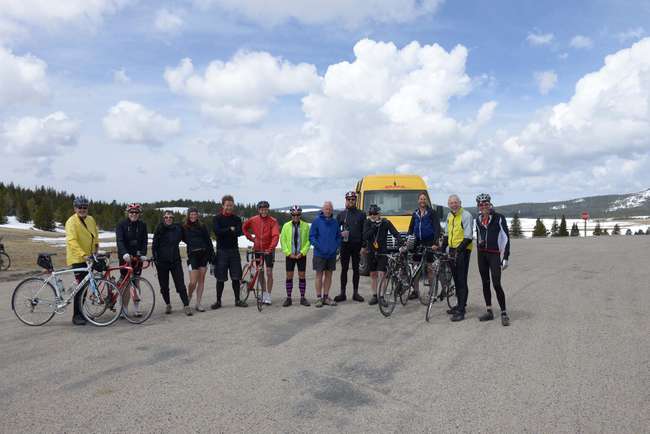
British architect, journalist, and cyclist Peter Murray has embarked on a bike ride from Portland, Oregon, to Portland Place in London. As he makes the 4,347-mile journey with a rotating group of participants, he plans to survey the state of cycling in American cities, meet up with members of the design community, and raise funds for Architecture for Humanity and U.K. relief organization Article 25.
Along the way, Murray is filing updates about his progress for Architectural Record.
 |
| Photo courtesy Peter Murray On the road. |
Just what we Brits can learn from the U.S. is top of my mind as I bike across America with a dozen architects and planners studying cycling infrastructure in cities. We have so far travelled through Oregon, Washington, Idaho, Montana, and now South Dakota. In this part of the world, cities themselves are few and far between, let alone ones that cater for cyclists.
Of course, our own attitudes and those of the areas we pass through are changing. In my last dispatch I was taken with the way U.S. truckers give you much more space than British lorry drivers—but whether this is just because they are so astonished to see a bunch of cyclists rather than good road skills, we still have to discover. While in Oregon I thought the ubiquitous fog line provided an ideal cycle path—the area was wide and clean and felt safe. In Idaho, Montana, and Wyoming the strip outside the fog line was narrower and covered in gravel. In South Dakota they cut the rumble strip across the full width of the path making riding very uncomfortable. Clearly South Dakota road planners never expected cyclists to use their highways. We are enjoying the beautiful scenery but looking forward to arriving in Minneapolis, Chicago, and cities east, where the urban cycling culture is stronger.
When people ask me what we can learn from the U.S., I point out that in the 1960s, American thinkers like Jane Jacobs, William H. Whyte, and Bernard Rudofsky were way ahead of us Brits in the discussion of placemaking in cities and the way the balance of use needed to change. A lot of the work that New York City Mayor Michael Bloomberg and his administration have done to improve public space as well as cycling infrastructure stems back to these figures.
So what can a bunch of architects add to the packed debate about cycling in cities? Architects shape our cities, yet, with rare exceptions like Jan Gehl, they do not have a voice in the discussion about creating the right balance of uses in them. The fight against the automobile’s domination is led by activists and partisans, not by those who design the urban fabric. I was very pleased that the riders who signed up for the Portland Oregon to Portland Place ride came from such appropriate backgrounds. The peloton includes:
- Bob West, a retired public service planner who well understands the political balancing act that is needed to bring about radical change in the way city streets are managed.
- Mike Lowe, a planner with Arup who worked on the Stratford City masterplan, which formed part of the site for the 2012 Olympics.
- Nic Crawley is head of sustainability at Allford Hall Monaghan Morris, which is currently designing the new headquarters for Google, with bike parking for 50 percent of the workers. Google has asked for a LEED platinum certification at a minimum.
- Tom Dollard works for housing architects Pollard Thomas and Edwards Architects; with 5-6,000 units in the office at any time, he makes sure architects are up to speed on sustainability issues.
- Robert Cohen works for climate change consultancy Verco and provides post-occupancy evaluations.
- Heinz Richardson is a director at Jestico + Whiles and has particular expertise in sustainable design.
This wealth of experience will help us to evaluate findings from our journey, both in terms of implementation as well as the development of a more sustainable future. The commitment of this team to promote change in the urban environment is something I find hugely encouraging.
I hope in some small way our ride and our research will help support the shift towards more human-centric cities and away from the dominance of the car that Jacobs, White, and Rudofsky championed so long ago. But I don’t suppose the traffic engineers of South Dakota will take much notice!
Follow the ride at portlandtoportland.org.

Post a comment to this article
Report Abusive Comment